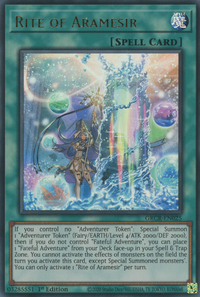Difference between revisions of "Series"
Golden Key (talk | contribs) (Good edits, but Frognarchs is a Deck-type comprised of two archetypes, not a series.) |
Dinoguy1000 (talk | contribs) (categories generally shouldn't be linked as "see also" entries from articles, doubly so when the article is categorized in that category) |
||
| (7 intermediate revisions by 3 users not shown) | |||
| Line 1: | Line 1: | ||
| − | + | {{Multiple image | |
| + | | width = 200 | ||
| + | | image1 = WaterEnchantressoftheTemple-GRCR-EN-UR-1E.png | ||
| + | | alt1 = Water Enchantress of the Temple | ||
| + | | caption1 = "[[Water Enchantress of the Temple]]" | ||
| + | | image2 = RiteofAramesir-GRCR-EN-UR-1E.png | ||
| + | | alt2 = Rite of Aramesir | ||
| + | | caption2 = "[[Rite of Aramesir]]" | ||
| + | | footer = These two cards lack a shared name string, but both interact with "[[Adventurer Token]]" and have shared artwork themes. As such, they are considered to be members of the "[[Adventurer]]" series. | ||
| + | }} | ||
| − | A | + | A '''series''' (シリーズ ''Shirīzu''){{Citation needed}} is a group of cards with similar name, artwork, and/or effect design, but do not have a single shared name string that is supported by a card effect that are present in [[archetype]]s.{{Citation needed}} |
| − | + | Unlike archetypes, which are most often explicitly intended to be built into proper Decks, series may or may not be glued comprehensively together, especially during the very early days of the game's history. More modern takes of series usually enable them to be built into proper Decks more reliably, not dissimilar to archetypes. This is done usually through supports that don't rely on name strings, such as [[Mentions|mentioning]] card(s) that glued them together, or supporting certain gimmicks that don't necessitate archetypal name string usages, thus blurring the distinction between them and archetypes even further. | |
| − | + | An example of a series is [[Digital Bug]]; there are cards with the "Digital Bug" name string (e.g. "[[Digital Bug Centibit]]" and "[[Digital Bug Rhinosebus]]"), they have similar visual designs, and similar card effects revolving around [[Insect]] monsters and [[Xyz Summon]]ing, but there are no cards with an effect that specifically affects cards with the "Digital Bug" name string. | |
| + | |||
| + | Series commonly, but not exclusively, comprise themed groups used by characters in the anime or manga. A group of cards may be a series in one media and an archetype in another. Examples of this include the [[Shark (series)|Shark]] and [[White]] cards, which are both archetypes in the anime and manga, respectively, but lack archetypal support in the ''TCG''/''OCG''. Also, a member of a series may also be a part of an archetype, an example being the [[Ultimate Insect]] series, whose members are all part of the "[[LV]]" archetype. | ||
| + | |||
| + | In ''[[Yu-Gi-Oh! Rush Duel]]'', since there is a lack of a proper archetype name string mechanic, all themes that appear in the game are exclusively played as series (even those that appeared as archetypes in the ''OCG''/''TCG'' like [[Dark Magician (archetype)|Dark Magician]] and [[Archfiend]]), a majority of which are based around using a specific [[Type]], [[Attribute]], and/or stat combinations. | ||
{{Gameplay}} | {{Gameplay}} | ||
[[Category:Series| ]] | [[Category:Series| ]] | ||
Latest revision as of 01:09, 21 February 2024
A series (シリーズ Shirīzu)[citation needed] is a group of cards with similar name, artwork, and/or effect design, but do not have a single shared name string that is supported by a card effect that are present in archetypes.[citation needed]
Unlike archetypes, which are most often explicitly intended to be built into proper Decks, series may or may not be glued comprehensively together, especially during the very early days of the game's history. More modern takes of series usually enable them to be built into proper Decks more reliably, not dissimilar to archetypes. This is done usually through supports that don't rely on name strings, such as mentioning card(s) that glued them together, or supporting certain gimmicks that don't necessitate archetypal name string usages, thus blurring the distinction between them and archetypes even further.
An example of a series is Digital Bug; there are cards with the "Digital Bug" name string (e.g. "Digital Bug Centibit" and "Digital Bug Rhinosebus"), they have similar visual designs, and similar card effects revolving around Insect monsters and Xyz Summoning, but there are no cards with an effect that specifically affects cards with the "Digital Bug" name string.
Series commonly, but not exclusively, comprise themed groups used by characters in the anime or manga. A group of cards may be a series in one media and an archetype in another. Examples of this include the Shark and White cards, which are both archetypes in the anime and manga, respectively, but lack archetypal support in the TCG/OCG. Also, a member of a series may also be a part of an archetype, an example being the Ultimate Insect series, whose members are all part of the "LV" archetype.
In Yu-Gi-Oh! Rush Duel, since there is a lack of a proper archetype name string mechanic, all themes that appear in the game are exclusively played as series (even those that appeared as archetypes in the OCG/TCG like Dark Magician and Archfiend), a majority of which are based around using a specific Type, Attribute, and/or stat combinations.

